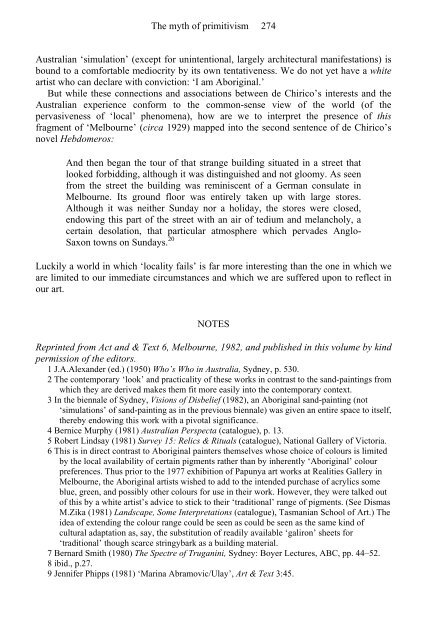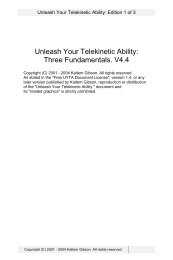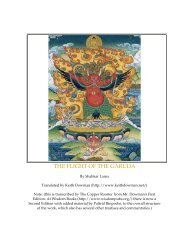Hiller - The Myth of Primitivism. Perspectives on Art - Esoteric Online
Hiller - The Myth of Primitivism. Perspectives on Art - Esoteric Online
Hiller - The Myth of Primitivism. Perspectives on Art - Esoteric Online
You also want an ePaper? Increase the reach of your titles
YUMPU automatically turns print PDFs into web optimized ePapers that Google loves.
<str<strong>on</strong>g>The</str<strong>on</strong>g> myth <str<strong>on</strong>g>of</str<strong>on</strong>g> primitivism 274<br />
Australian ‘simulati<strong>on</strong>’ (except for unintenti<strong>on</strong>al, largely architectural manifestati<strong>on</strong>s) is<br />
bound to a comfortable mediocrity by its own tentativeness. We do not yet have a white<br />
artist who can declare with c<strong>on</strong>victi<strong>on</strong>: ‘I am Aboriginal.’<br />
But while these c<strong>on</strong>necti<strong>on</strong>s and associati<strong>on</strong>s between de Chirico’s interests and the<br />
Australian experience c<strong>on</strong>form to the comm<strong>on</strong>-sense view <str<strong>on</strong>g>of</str<strong>on</strong>g> the world (<str<strong>on</strong>g>of</str<strong>on</strong>g> the<br />
pervasiveness <str<strong>on</strong>g>of</str<strong>on</strong>g> ‘local’ phenomena), how are we to interpret the presence <str<strong>on</strong>g>of</str<strong>on</strong>g> this<br />
fragment <str<strong>on</strong>g>of</str<strong>on</strong>g> ‘Melbourne’ (circa 1929) mapped into the sec<strong>on</strong>d sentence <str<strong>on</strong>g>of</str<strong>on</strong>g> de Chirico’s<br />
novel Hebdomeros:<br />
And then began the tour <str<strong>on</strong>g>of</str<strong>on</strong>g> that strange building situated in a street that<br />
looked forbidding, although it was distinguished and not gloomy. As seen<br />
from the street the building was reminiscent <str<strong>on</strong>g>of</str<strong>on</strong>g> a German c<strong>on</strong>sulate in<br />
Melbourne. Its ground floor was entirely taken up with large stores.<br />
Although it was neither Sunday nor a holiday, the stores were closed,<br />
endowing this part <str<strong>on</strong>g>of</str<strong>on</strong>g> the street with an air <str<strong>on</strong>g>of</str<strong>on</strong>g> tedium and melancholy, a<br />
certain desolati<strong>on</strong>, that particular atmosphere which pervades Anglo-<br />
Sax<strong>on</strong> towns <strong>on</strong> Sundays. 20<br />
Luckily a world in which ‘locality fails’ is far more interesting than the <strong>on</strong>e in which we<br />
are limited to our immediate circumstances and which we are suffered up<strong>on</strong> to reflect in<br />
our art.<br />
NOTES<br />
Reprinted from Act and & Text 6, Melbourne, 1982, and published in this volume by kind<br />
permissi<strong>on</strong> <str<strong>on</strong>g>of</str<strong>on</strong>g> the editors.<br />
1 J.A.Alexander (ed.) (1950) Who’s Who in Australia, Sydney, p. 530.<br />
2 <str<strong>on</strong>g>The</str<strong>on</strong>g> c<strong>on</strong>temporary ‘look’ and practicality <str<strong>on</strong>g>of</str<strong>on</strong>g> these works in c<strong>on</strong>trast to the sand-paintings from<br />
which they are derived makes them fit more easily into the c<strong>on</strong>temporary c<strong>on</strong>text.<br />
3 In the biennale <str<strong>on</strong>g>of</str<strong>on</strong>g> Sydney, Visi<strong>on</strong>s <str<strong>on</strong>g>of</str<strong>on</strong>g> Disbelief (1982), an Aboriginal sand-painting (not<br />
‘simulati<strong>on</strong>s’ <str<strong>on</strong>g>of</str<strong>on</strong>g> sand-painting as in the previous biennale) was given an entire space to itself,<br />
thereby endowing this work with a pivotal significance.<br />
4 Bernice Murphy (1981) Australian Perspecta (catalogue), p. 13.<br />
5 Robert Lindsay (1981) Survey 15: Relics & Rituals (catalogue), Nati<strong>on</strong>al Gallery <str<strong>on</strong>g>of</str<strong>on</strong>g> Victoria.<br />
6 This is in direct c<strong>on</strong>trast to Aboriginal painters themselves whose choice <str<strong>on</strong>g>of</str<strong>on</strong>g> colours is limited<br />
by the local availability <str<strong>on</strong>g>of</str<strong>on</strong>g> certain pigments rather than by inherently ‘Aboriginal’ colour<br />
preferences. Thus prior to the 1977 exhibiti<strong>on</strong> <str<strong>on</strong>g>of</str<strong>on</strong>g> Papunya art works at Realities Gallery in<br />
Melbourne, the Aboriginal artists wished to add to the intended purchase <str<strong>on</strong>g>of</str<strong>on</strong>g> acrylics some<br />
blue, green, and possibly other colours for use in their work. However, they were talked out<br />
<str<strong>on</strong>g>of</str<strong>on</strong>g> this by a white artist’s advice to stick to their ‘traditi<strong>on</strong>al’ range <str<strong>on</strong>g>of</str<strong>on</strong>g> pigments. (See Dismas<br />
M.Zika (1981) Landscape, Some Interpretati<strong>on</strong>s (catalogue), Tasmanian School <str<strong>on</strong>g>of</str<strong>on</strong>g> <strong>Art</strong>.) <str<strong>on</strong>g>The</str<strong>on</strong>g><br />
idea <str<strong>on</strong>g>of</str<strong>on</strong>g> extending the colour range could be seen as could be seen as the same kind <str<strong>on</strong>g>of</str<strong>on</strong>g><br />
cultural adaptati<strong>on</strong> as, say, the substituti<strong>on</strong> <str<strong>on</strong>g>of</str<strong>on</strong>g> readily available ‘galir<strong>on</strong>’ sheets for<br />
‘traditi<strong>on</strong>al’ though scarce stringybark as a building material.<br />
7 Bernard Smith (1980) <str<strong>on</strong>g>The</str<strong>on</strong>g> Spectre <str<strong>on</strong>g>of</str<strong>on</strong>g> Truganini, Sydney: Boyer Lectures, ABC, pp. 44–52.<br />
8 ibid., p.27.<br />
9 Jennifer Phipps (1981) ‘Marina Abramovic/Ulay’, <strong>Art</strong> & Text 3:45.




